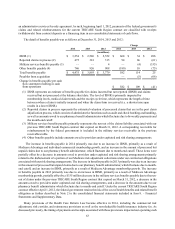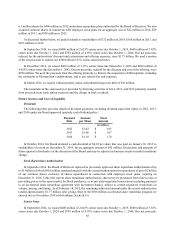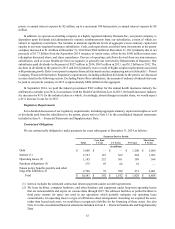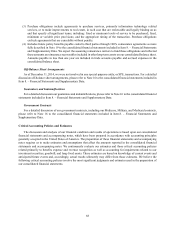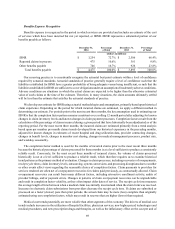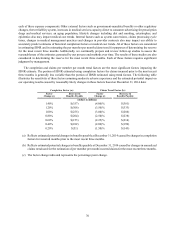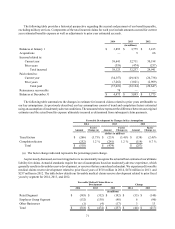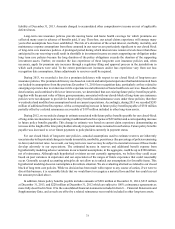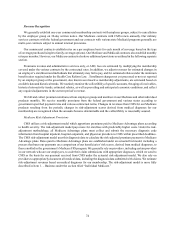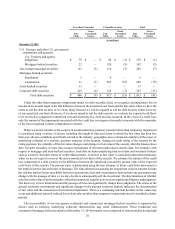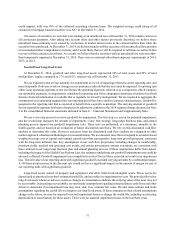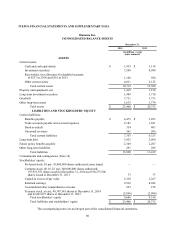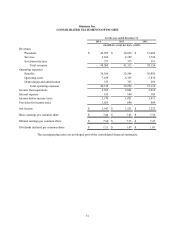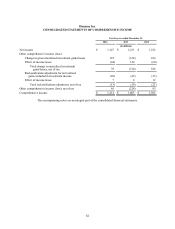Humana 2014 Annual Report Download - page 81
Download and view the complete annual report
Please find page 81 of the 2014 Humana annual report below. You can navigate through the pages in the report by either clicking on the pages listed below, or by using the keyword search tool below to find specific information within the annual report.73
liability at December 31, 2013. Amounts charged to accumulated other comprehensive income are net of applicable
deferred taxes.
Long-term care insurance policies provide nursing home and home health coverage for which premiums are
collected many years in advance of benefits paid, if any. Therefore, our actual claims experience will emerge many
years after assumptions have been established. The risk of a deviation of the actual interest, morbidity, mortality, and
maintenance expense assumptions from those assumed in our reserves are particularly significant to our closed block
of long-term care insurance policies. A prolonged period during which interest rates remain at levels lower than those
anticipated in our reserving would result in shortfalls in investment income on assets supporting our obligation under
long term care policies because the long duration of the policy obligations exceeds the duration of the supporting
investment assets. Further, we monitor the loss experience of these long-term care insurance policies and, when
necessary, apply for premium rate increases through a regulatory filing and approval process in the jurisdictions in
which such products were sold. To the extent premium rate increases and/or loss experience vary from our loss
recognition date assumptions, future adjustments to reserves could be required.
During 2013, we recorded a loss for a premium deficiency with respect to our closed block of long-term care
insurance policies. The premium deficiency was based on current and anticipated experience that had deteriorated from
our locked-in assumptions from the previous December 31, 2010 loss recognition date, particularly as they related to
emerging experience due to an increase in life expectancies and utilization of home health care services. Based on this
deterioration, and combined with lower interest rates, we determined that our existing future policy benefits payable,
together with the present value of future gross premiums, associated with our closed-block of long-term care insurance
policies were not adequate to provide for future policy benefits and maintenance costs under these policies; therefore
we unlocked and modified our assumptions based on current expectations. Accordingly, during 2013 we recorded $243
million of additional benefits expense, with a corresponding increase in future policy benefits payable of $350 million
partially offset by a related reinsurance recoverable of $107 million included in other long-term assets.
During 2012, we recorded a change in estimate associated with future policy benefits payable for our closed-block
of long-term care insurance policies resulting in additional benefits expense of $29 million and a corresponding increase
in future policy benefits payable. This change in estimate was based on current claim experience demonstrating an
increase in the length of the time policyholders already in payment status remained in such status. Future policy benefits
payable was increased to cover future payments to policyholders currently in payment status.
For our closed block of long-term care policies, actuarial assumptions used to estimate reserves are inherently
uncertain due to the potential changes in trends in mortality, morbidity, persistency (the percentage of policies remaining
in-force) and interest rates. As a result, our long term care reserves may be subject to material increases if these trends
develop adversely to our expectations. The estimated increase in reserves and additional benefit expense from
hypothetically modeling adverse variations in our actuarial assumptions, in the aggregate, could be up to $300 million,
net of reinsurance. Although such hypothetical revisions are not currently appropriate, we believe they could occur
based on past variances in experience and our expectation of the ranges of future experience that could reasonably
occur. Generally accepted accounting principles do not allow us to unlock our assumptions for favorable items. This
hypothetical modeling does not contemplate a divestiture situation. We are evaluating alternatives related to our closed
block of long term care policies. While no decision has been made with respect to any course of action, if we were to
divest this business, it is reasonably likely that we would have to recognize a material loss and that loss could exceed
the amount provided above.
In addition, future policy benefits payable includes amounts of $210 million at December 31, 2014, $215 million
at December 31, 2013, and $220 million at December 31, 2012 which are subject to 100% coinsurance agreements as
more fully described in Note 19 to the consolidated financial statements included in Item 8. – Financial Statements and
Supplementary Data, and as such are offset by a related reinsurance recoverable included in other long-term assets.


